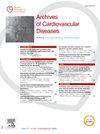Rendu Osler压力超声心动图(ROSE)
IF 2.3
3区 医学
Q2 CARDIAC & CARDIOVASCULAR SYSTEMS
引用次数: 0
摘要
背景遗传性出血性毛细血管扩张(HHT)的肝脏受累以动脉-肝分流为特征,可导致高心输出量心力衰竭(HCO-HF)。这从无症状舒张性心力衰竭发展为静息性肺动脉高压(PH),这实际上是肝移植(LT)候选所必需的。然而,当存在PH时,肝移植后HCO-HF的改善是不确定的,因为这种转诊可能发生得太晚了。目的:我们假设HHT伴肝受累患者运动时的异常肺压反应可先于运动超声心动图检测到的休息时的PH值,并可能与BSA (CO)指标的休息时心输出量部分相关。方法:rose是一项针对40例肝动脉直径≥6mm的HHT患者的初步研究。中位CO值将人群分为两组:高心输出量组(HCO组)和正常心输出量组(NCO组)。患者未接受β受体阻滞剂治疗,处于窦性心律。在静息、20 W和运动高峰时,对CO、左心室(LV)和心房(LA)的容量和功能以及收缩压(sPAP)进行应激超声心动图检查。终点为各组间sPAP(主要)和sPAP/CO斜率(次要)从休息到运动高峰的演变比较。结果在33例患者中,我们发现HCO和NCO患者在休息和运动高峰时的sPAP没有差异(表1)。然而,sPAP/CO斜率在HCO组中更高,特别是在4例患者中,在运动期间,相对较小的CO增加,sPAP增加更大(图1,图2)。结论对于累及肝脏的HHT患者,在运动超声心动图中评估sPAP对HCO-HF早期阶段的识别是有希望的,特别是在评估CO升高与sPAP升高之间的关系时。sPAP/CO斜率应进一步研究,作为接近于休息PH的早期标志。本文章由计算机程序翻译,如有差异,请以英文原文为准。
Rendu Osler Stress Echocardiography (ROSE)
Background
The hepatic involvement in Hereditary Hemorrhagic Telangiectasia (HHT) is characterized by arterio-sus-hepatic shunts that can lead to high cardiac output heart failure (HCO-HF). This develops from asymptomatic diastolic heart failure to rest pulmonary hypertension (PH), which is actually required for liver tranplantation (LT) candidacy. However, when PH is present, HCO-HF improvement after LT is uncertain since such referral may possibly occur too late.
Objectives
We hypothesized that abnormal pulmonary pressure response during exercice in HHT patients with hepatic involvement can precede rest PH can be detected during exercise echocardiography and may be partially related to rest cardiac output indexed to BSA (CO).
Methods
ROSE is a pilot study of 40 HHT patients with hepatic involvement as defined by a hepatic artery diameter ≥ 6 mm,. Median CO value divided the population in 2 groups: high cardiac output (HCO group) vs normal cardiac output (NCO group). Patients were in sinus rhythm without betablocker treatment. Stress echocardiography was performed for CO, left ventricular (LV) and atrial (LA) volumes and functions, and systolic pulmonary arterial pressure (sPAP) at rest, 20 W, and peak exercise. Endpoints were the comparison between groups of the evolution of sPAP (primary) and sPAP/CO slopes (secondary) from rest to peak exercise.
Results
Among 33 patients, we found no difference in sPAP at rest nor at peak exercise between HCO and NCO patients (Table 1). However, sPAP/CO slopes were higher in the HCO group especially in 4 patients exhibiting a greater sPAP increase for a relative smaller CO increase during exercise (Figure 1, Figure 2).
Conclusion
In HHT patients with hepatic involvement, sPAP assessment during exercise echocardiography for the identification of earlier stages of HCO-HF can be promising, especially when assessing the relationships between CO increase and sPAP increase. The sPAP/CO slope should be further investigated as an early marker nearly preceding rest PH.
求助全文
通过发布文献求助,成功后即可免费获取论文全文。
去求助
来源期刊

Archives of Cardiovascular Diseases
医学-心血管系统
CiteScore
4.40
自引率
6.70%
发文量
87
审稿时长
34 days
期刊介绍:
The Journal publishes original peer-reviewed clinical and research articles, epidemiological studies, new methodological clinical approaches, review articles and editorials. Topics covered include coronary artery and valve diseases, interventional and pediatric cardiology, cardiovascular surgery, cardiomyopathy and heart failure, arrhythmias and stimulation, cardiovascular imaging, vascular medicine and hypertension, epidemiology and risk factors, and large multicenter studies. Archives of Cardiovascular Diseases also publishes abstracts of papers presented at the annual sessions of the Journées Européennes de la Société Française de Cardiologie and the guidelines edited by the French Society of Cardiology.
 求助内容:
求助内容: 应助结果提醒方式:
应助结果提醒方式:


